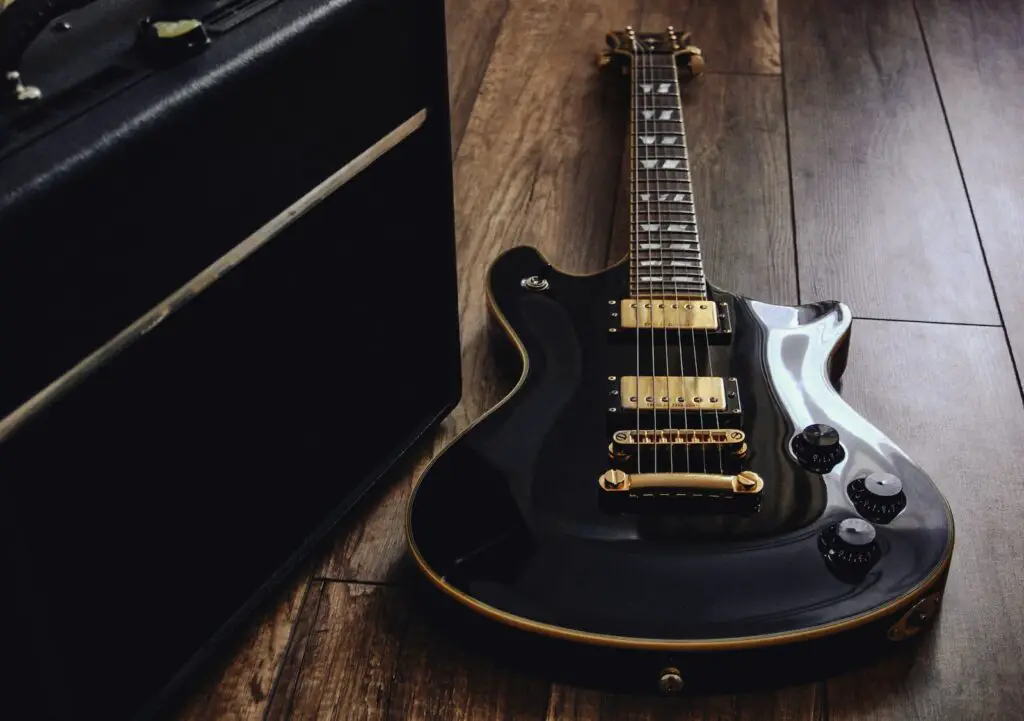Many professional guitarists often utilize electric guitars to perform acoustic songs. However, some key distinctions between acoustic and electric guitars should be considered when transitioning.
Acoustic guitars tend to produce warmer tones due to their hollow bodies that amplify the sound produced by strings.
On the other hand, electric guitars rely on pickups and amplifiers, which may produce too bright or sharp sound for some acoustic songs.
Electric guitars differ from acoustic guitars in sound and technique, but they can produce a similar sound to an acoustic guitar with the right setup and techniques.
Playing Acoustic Guitar Songs on an Electric Guitar
Playing acoustic songs on an electric guitar can be daunting for some guitarists.
To achieve the same pure and warm sound as an acoustic guitar, it is recommended that you first turn off any distortion in your amplifier.
Though some songs benefit from crunch, starting with a clean sound is best and gradually adding distortion and crunch as you progress.
This method will make transitioning from acoustic to electric guitar much smoother.
It is essential to know that the technique for playing an acoustic song on an electric guitar may vary depending on your music style.
Fingerstyle playing may require you to adjust your picking style to achieve the desired sound.
Furthermore, using a capo can help recreate the sound of an acoustic guitar when playing electric.
The Difficulty of Transitioning From Acoustic to Electric Guitar
The transition from an acoustic to electric guitar may be more manageable than you first believed. Playing an electric guitar may be less challenging.
These instruments typically have thinner strings and lower action, making it simpler to fret chords.
Thus, playing complex chord progressions and intricate melodies on an electric guitar becomes much simpler.
However, knowing the differences between electric and acoustic guitars is essential. When playing electric guitar, your sound is amplified through pickups and an amplifier.
This may produce too bright or sharp sound for acoustic songs. To compensate, adjust your amplifier settings so that the tone resembles an acoustic guitar’s.
Does Playing The Acoustic Guitar Make It Easy To Learn Electric Guitar?
Your choice will largely depend on your preferences and why you want to pursue guitar playing in the first place.
Playing electric guitars offers several advantages over standard guitars, such as lighter gauge strings and lower action that require you to press down less hard for a clear note.
Electric guitars allow for experimentation with various sounds and effects, giving you greater control over your playing tone.
Acoustic guitars are renowned for their warm, natural, and organic sound produced by their strings’ hollow body and resonance.
The tone can differ depending on factors like the wood type for the body, string thickness, and how the guitar is played.
Many guitarists appreciate a more unprocessed approach to sound production.
Acoustic guitars provide a convenient and portable option for musicians who like to take their music on the go.
These instruments can be played in various settings, from small intimate venues to large outdoor stages, making them highly versatile instruments with many applications.
Do Acoustic Guitar Chords Differ From Electric Guitar Chords?
Electric guitar chords are fundamentally the same as those played on an acoustic guitar. However, some have been specifically composed for electric instruments, which typically produce a richer and more complex sound when played through one of these instruments.
Due to its amplifying capabilities, arpeggios and open chords may sound more dynamic and elaborate when played through an electric guitar.
When playing chords on the guitar, there is often significant overlap between those played on an acoustic and electric guitar.
Many of the chords commonly played on an acoustic guitar can easily be adapted on an electric guitar without any modifications needed – including standard major and minor chords, which can be played both ways.
Does Learning To Play Electric Guitar Before An Acoustic Guitar Makes Sense?
Electric guitars offer a great starting point, as their strings tend to be thinner than those on traditional guitars.
The string gauge is thinner, which requires less finger strength and makes it simpler for beginners to fret notes and chords accurately.
Electric guitars typically feature a slimmer neck profile which may benefit players with smaller hands.
The narrower neck and fretboard provide a comfortable grip and shorter reach between frets, so players can focus on learning proper finger placement and chord shapes without straining their hands.
Electric guitars are often preferred for lead guitarists due to their light string tension, making bending notes and executing intricate solo techniques simpler.
Electric guitars offer many tonal possibilities that can be tweaked with various effects, pedals, and amplifiers.
At What Age Should One Begin Learning How To Play The Electric Guitar?
Playing the guitar can be an exhilarating and fulfilling experience, and it doesn’t need to be done at a certain age.
All that’s necessary to begin is holding the instrument comfortably and pressing its strings with agility and coordination.
There is no ideal age to learn this exciting skill; anyone from children of age 6 through adults can join this exciting journey, provided they possess sufficient coordination to manipulate the instrument.
It’s essential to consider that the learning process may differ depending on a player’s age. Young children may require more structured lessons and guidance, while older individuals may enjoy greater study autonomy.
Anyone can gain proficiency at playing guitar through dedication and practice.
Can I Strum The Strings Of An Electric Guitar?
Strumming guitar strings with your hand is a popular technique that produces distinct tones on electric and acoustic guitars.
Electric guitars feature thinner strings than their acoustic guitar counterparts, creating a smoother and faster action.
These instruments often have more amplified sounds due to pickups and amplifiers. Acoustic guitars offer a more organic and raw tone due solely to the vibrations generated by the strings amplified by the guitar’s hollow body.
Acoustic guitar strings vibrate more intensely than their electric guitar counterparts, creating inviting warmth and rich sound unique to this instrument.
Acoustic and electric guitars each possess distinct tonal characteristics that set them apart. Electric guitars offer more options than acoustic ones, giving musicians’ greater versatility. Electric guitars often feature multiple pickups and tone knobs, enabling players to customize the sound according to preferences.





